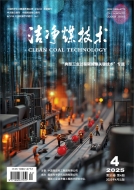Slagging is a serious problem limiting the large - scale combustion and utilization of coal ashes with high alkali. Two typesof combustion boiler slags with a high alkali metal and high alkaline earth metals respectively were used to investigate the slagging tenden⁃cy and slagging process by ash fusion temperature tester, thermomechanical analyzer, thermogravimetric-differential scanning calorimeter,XRD, and thermodynamic software FactSage. It is found that the alkali metal in the high alkali ash slag mainly exists in silicoaluminate,while the alkaline earth metal mainly exists in sulfate. The initial sintering temperature of high alkali coal ash slags (SH and PG) is higherthan the coal ash slags with high alkaline elements (GJ and CQ), but the ash fusion temperature range of GJ and CQ is larger than SHand PG. Both initial sintering temperature and deposition index can be used to evaluate the slagging tendency of coal ashes with high basicoxides, but there is no direct relationship between the slagging tendency discrimination index and the chemical composition of the ashCaO, K2O+Na2O, SiO2 / Al2O3, alkali acid ratio B/ A, and the content of alkaline earth metal calcium sulfate and alkaline metal silicateAluminate in the mineral composition. The melting of coal ashes with high basic oxides mainly passed through two stages. The first stageis connected to the melting of low-melting-point alkali metal minerals (albite, nepheline) or the reaction with other minerals in coal ash(quartz, albite) to form the initial liquid phase, the second stage is mainly dominated by low-temperature eutectics which are formed bypyroxene and feldspar.
Slagging tendency and process of coal ashes with high alkali
 2023 No. 07
2023 No. 07
 812
812 439
439

Authors:
- SHI Wenju
- YAN Jingchong
- BAI Jin
- CAO Jingpei

Unit:
- Jiangsu Province Engineering Research Center of Fine Utilization of Carbon Resources,China University of Mining & Technology
- School of Chemistry & Chemical Engineering,Anhui University of Technology
- State Key Laboratory of Coal Conversion,Institute of Coal Chemistry,Chinese Academy of Sciences

Abstract:

Keywords:
- high alkali coal ash
- initial sintering temperature
- ash fusion temperatures
- slagging tendency
- fusion process

Citation format:
石文举(1994—),男,甘肃庄浪人,副教授,博士。E-mail:shiwenju@cumt.edu.cn

Chart:

Articles:
--

Citation format:
SHI Wenju,YAN Jingchong,BAI Jin,et al.Slagging tendency and process of coal ashes with high alkali[J].Clean Coal Technology,2023,29(7):140-147.

-
Executive director
China Coal Science and Industry Group Co., Ltd
-
Sponsored by
Coal Science Research Institute Co., Ltd
Coal Industry Clean Coal Engineering
Technology Research Center -
Editor in Chief
XIE Qiang
-
Vice Editor-in-Chief
YU Chang
SHI Yixiang
ZHAO Yongchun
DUAN Linbo
CAO Jingpei
ZENG Jie -
Publication Frequencies
Monthly
-
ISSN
1006-6772
-
CN
11-3676/TD
Covered by
- CSTPCD
- RCCSE(A+)
- AJ
- EBSCO host
- Ulrichsweb
- JST
- Scopus
Contact us
New Media
-
 Meichuanmei
Meichuanmei -
 Clean Coal Technology
Clean Coal Technology -
 Online Journals
Online Journals









 Submission system
Submission system Copyright agreement
Copyright agreement Instructions for authors
Instructions for authors